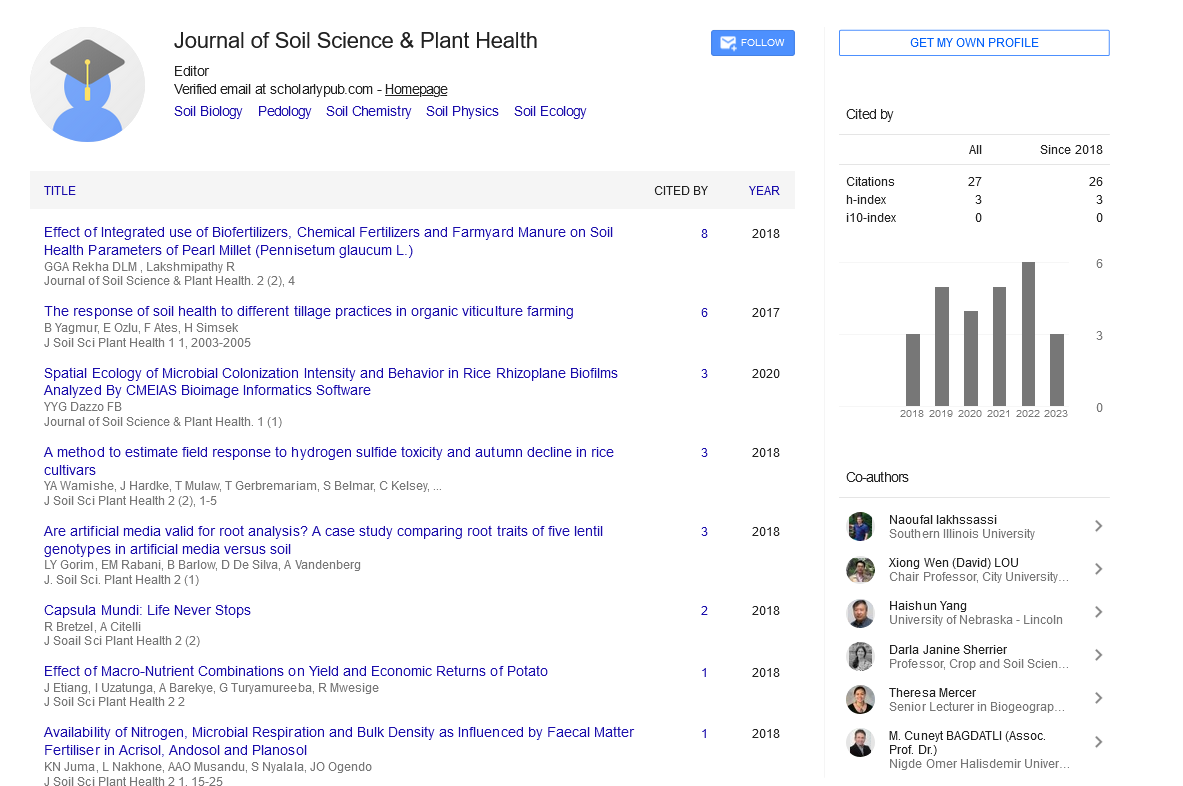Opinion Article, J Soil Sci Plant Health Vol: 8 Issue: 1
Mycorrhizal Symbiosis Promoting Plant Health and Ecosystem Sustainability
Nam Jae*
Department of Plant Science, California State University, Fresno, 2415 E. San Ramon Ave., M/S AS72, Fresno, CA 93740, USA
- *Corresponding Author:
- Nam Jae
Department of Plant Science,
California State University,
Fresno,
2415
E. San Ramon Ave.,
M/S AS72,
Fresno,
CA 93740,
USA
E-mail: namjae32@gmail.com
Received date: 27 October, 2023, Manuscript No. JSPH-23-118469;
Editor assigned date: 30 October, 2023, PreQC No. JSPH-23-118469 (PQ);
Reviewed date: 13 November, 2023, QC No. JSPH-23-118469;
Revised date: 05 January, 2024, Manuscript No. JSPH-23-118469 (R);
Published date: 12 January, 2024, DOI: 10.4172/jsph.1000217
Citation: Jae N (2024) Mycorrhizal Symbiosis Promoting Plant Health and Ecosystem Sustainability. J Soil Sci Plant Health J 8:1.
Description
The intricate relationships between plants and microorganisms in the soil have fascinated scientists for centuries. Among these relationships, mycorrhizal symbiosis, in which plants and fungi form mutually beneficial partnerships, plays a pivotal role in shaping plant health and ecosystem dynamics. Mycorrhizal associations are widespread in the plant kingdom and have been a subject of intense research due to their profound impact on plant growth, nutrient acquisition, and stress tolerance. This manuscript delves into the world of mycorrhizal symbiosis, highlighting its significance in promoting plant health and ecosystem sustainability.
Mycorrhizal symbiosis is a mutualistic association between plant roots and certain types of fungi, known as mycorrhizal fungi. This association enhances the performance of both partners in various ways:
Mycorrhizal fungi extend the reach of plant roots, increasing the volume of soil explored for nutrients, particularly phosphorus and nitrogen. In return, the fungi receive carbon compounds from the plant.
The fungal hyphae, fine threads of the mycorrhizal fungi, access nutrients that may be otherwise inaccessible to the plant due to their smaller size and greater surface area.
Mycorrhizal associations enhance a plant's ability to withstand environmental stresses, such as drought, salinity, and disease.
The fungal hyphae contribute to soil aggregation, improving soil structure and water infiltration.
There are several types of mycorrhizal associations, with the two most common being: Arbuscular mycorrhizal fungi form associations with a wide range of plant species, including many agricultural crops. The fungi produce tree-like structures called arbuscules within plant root cells, facilitating nutrient exchange.
Ectomycorrhizal fungi predominantly associate with woody plants, such as trees and shrubs. Unlike AM, they form a sheath around the plant root tips and extend into the surrounding soil.
Mycorrhizal symbiosis plays a pivotal role in promoting plant health and vitality:
Mycorrhizal associations significantly enhance a plant's ability to acquire essential nutrients, particularly phosphorus. This improved nutrient uptake contributes to increased plant growth and development.
Mycorrhizal plants tend to exhibit higher drought tolerance due to improved water uptake and water-use efficiency.
Some mycorrhizal associations can enhance a plant's resistance to soil-borne pathogens by stimulating the plant's defense mechanisms.
Mycorrhizal plants are often more efficient in utilizing available nutrients, reducing the need for synthetic fertilizers.
Mycorrhizal associations contribute to ecosystem services, such as improved soil structure, carbon sequestration, and nutrient cycling.
Mycorrhizal symbiosis extends its influence beyond individual plants and contributes to ecosystem dynamics:
Mycorrhizal associations facilitate the transfer of carbon from plants to soil, where it can be stored as organic matter, contributing to carbon sequestration and mitigating climate change.
Mycorrhizal fungi play a role in maintaining biodiversity by influencing plant community composition and interactions.
Ecosystems with diverse mycorrhizal associations are often more resilient in the face of environmental disturbances.
Despite the many advantages of mycorrhizal symbiosis, challenges remain in harnessing its full potential for sustainable agriculture and ecosystem management:
Not all plant species form mycorrhizal associations, and the effectiveness of these associations can vary between different mycorrhizal fungi and plant species.
There is a need for practical strategies to harness mycorrhizal symbiosis for agriculture, horticulture, and ecosystem restoration.
Climate change, land-use practices, and pollution can affect mycorrhizal associations and their functioning, with potential consequences for ecosystem health.
Conclusion
Mycorrhizal symbiosis is a remarkable example of mutualism in the natural world, with profound implications for plant health, ecosystem sustainability, and environmental management. Understanding the mechanisms and ecological significance of mycorrhizal associations is crucial for harnessing their potential in agriculture, conservation, and restoration efforts. As research in this field continues to advance, our knowledge of mycorrhizal symbiosis and its impacts on plant health and ecosystem resilience will contribute to more sustainable and environmentally friendly practices in various domains.
 Spanish
Spanish  Chinese
Chinese  Russian
Russian  German
German  French
French  Japanese
Japanese  Portuguese
Portuguese  Hindi
Hindi 